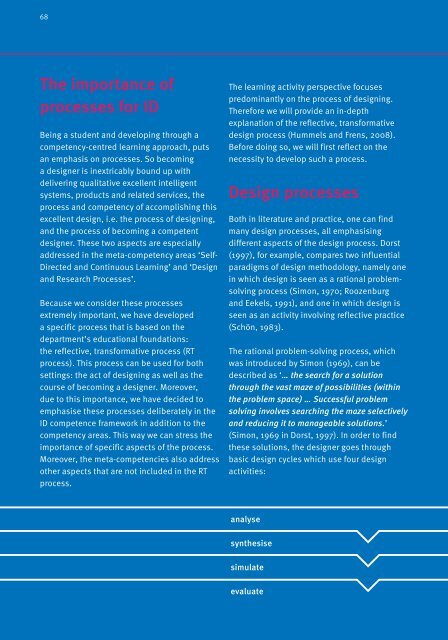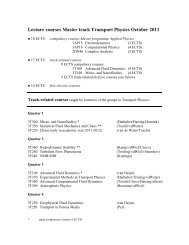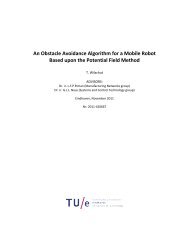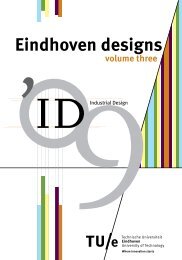Education guide 'Eindhoven designs' - Technische Universiteit ...
Education guide 'Eindhoven designs' - Technische Universiteit ...
Education guide 'Eindhoven designs' - Technische Universiteit ...
Create successful ePaper yourself
Turn your PDF publications into a flip-book with our unique Google optimized e-Paper software.
68<br />
The importance of<br />
processes for ID<br />
Being a student and developing through a<br />
competency-centred learning approach, puts<br />
an emphasis on processes. So becoming<br />
a designer is inextricably bound up with<br />
delivering qualitative excellent intelligent<br />
systems, products and related services, the<br />
process and competency of accomplishing this<br />
excellent design, i.e. the process of designing,<br />
and the process of becoming a competent<br />
designer. These two aspects are especially<br />
addressed in the meta-competency areas ‘Self-<br />
Directed and Continuous Learning’ and ‘Design<br />
and Research Processes’.<br />
Because we consider these processes<br />
extremely important, we have developed<br />
a specific process that is based on the<br />
department’s educational foundations:<br />
the reflective, transformative process (RT<br />
process). This process can be used for both<br />
settings: the act of designing as well as the<br />
course of becoming a designer. Moreover,<br />
due to this importance, we have decided to<br />
emphasise these processes deliberately in the<br />
ID competence framework in addition to the<br />
competency areas. This way we can stress the<br />
importance of specific aspects of the process.<br />
Moreover, the meta-competencies also address<br />
other aspects that are not included in the RT<br />
process.<br />
The learning activity perspective focuses<br />
predominantly on the process of designing.<br />
Therefore we will provide an in-depth<br />
explanation of the reflective, transformative<br />
design process (Hummels and Frens, 2008).<br />
Before doing so, we will first reflect on the<br />
necessity to develop such a process.<br />
Design processes<br />
Both in literature and practice, one can find<br />
many design processes, all emphasising<br />
different aspects of the design process. Dorst<br />
(1997), for example, compares two influential<br />
paradigms of design methodology, namely one<br />
in which design is seen as a rational problemsolving<br />
process (Simon, 1970; Roozenburg<br />
and Eekels, 1991), and one in which design is<br />
seen as an activity involving reflective practice<br />
(Schön, 1983).<br />
The rational problem-solving process, which<br />
was introduced by Simon (1969), can be<br />
described as ‘… the search for a solution<br />
through the vast maze of possibilities (within<br />
the problem space) … Successful problem<br />
solving involves searching the maze selectively<br />
and reducing it to manageable solutions.’<br />
(Simon, 1969 in Dorst, 1997). In order to find<br />
these solutions, the designer goes through<br />
basic design cycles which use four design<br />
activities:<br />
analyse<br />
synthesise<br />
simulate<br />
evaluate

















